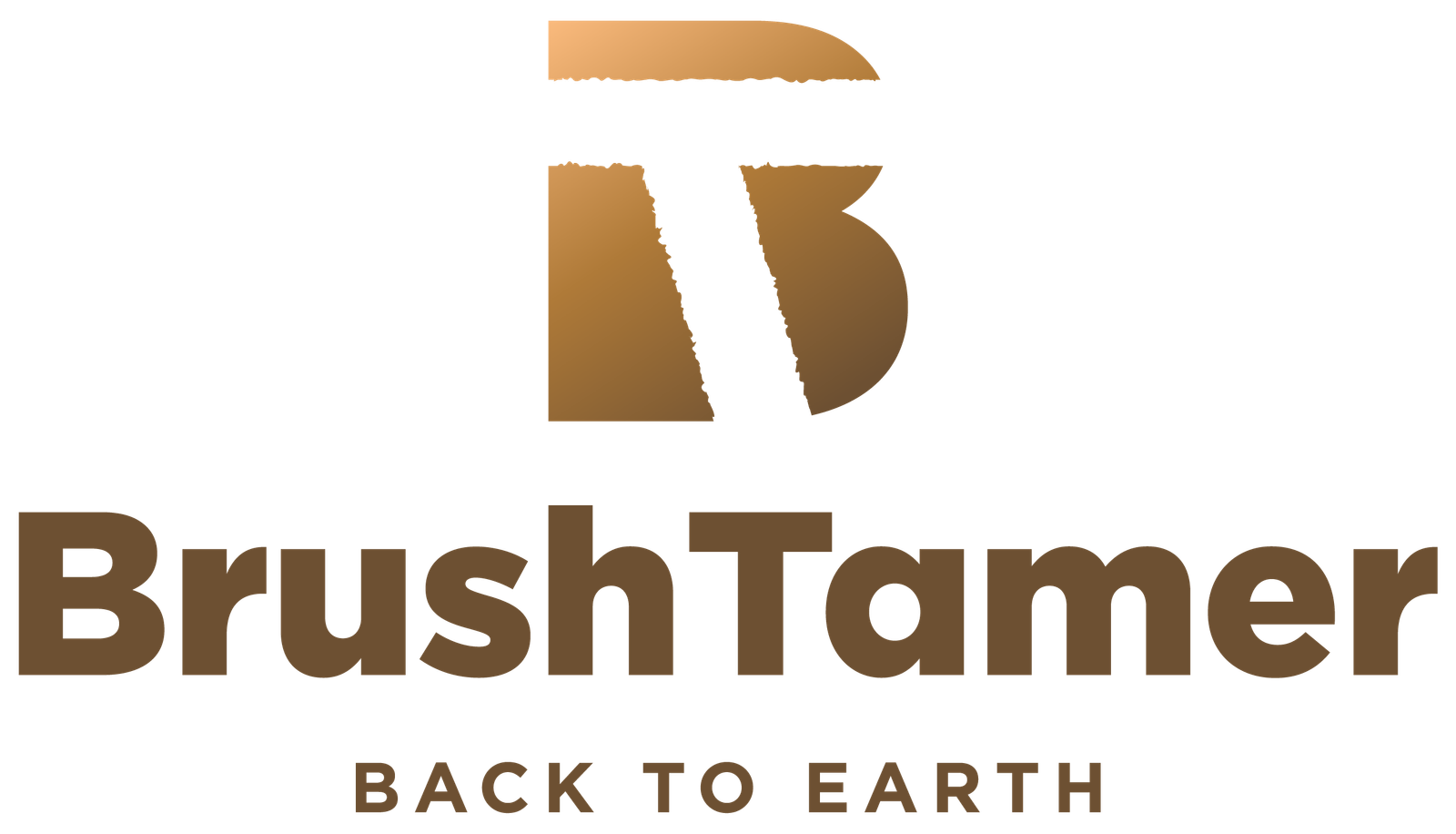What is Commercial Vegetation Management?
Commercial vegetation control is the systematic process of managing unwanted plant growth on business properties to maintain safety, aesthetics, and operational efficiency. This includes controlling weeds, invasive species, overgrown brush, and other undesirable vegetation that can create hazards, harbor pests, and damage your property’s professional appearance.
Key aspects of commercial vegetation control include:
- Target areas: Building perimeters, parking lots, fence lines, storage areas, and utility zones
- Methods: Physical removal, forestry mulching, selective herbicide application, and mechanical cutting
- Goals: Safety compliance, fire prevention, pest control, and professional appearance
- Frequency: Seasonal maintenance programs or one-time clearing projects
Uncontrolled vegetation creates serious problems for businesses. As noted in industry research, invasive weeds can be “fuel for fires and harborage for insects, rodents and other pests.” They also create negative first impressions – something that can directly impact your business reputation and property value.
The solution lies in Industrial Vegetation Management (IVM), a science-based approach that combines multiple control methods to achieve long-term results while protecting the environment.
I’m Leon Miller, owner of BrushTamer, and I’ve spent years helping commercial property owners reclaim overgrown areas through effective commercial vegetation control strategies. My hands-on experience with everything from forestry mulching to site preparation has shown me how proper vegetation management transforms properties while reducing long-term maintenance costs.
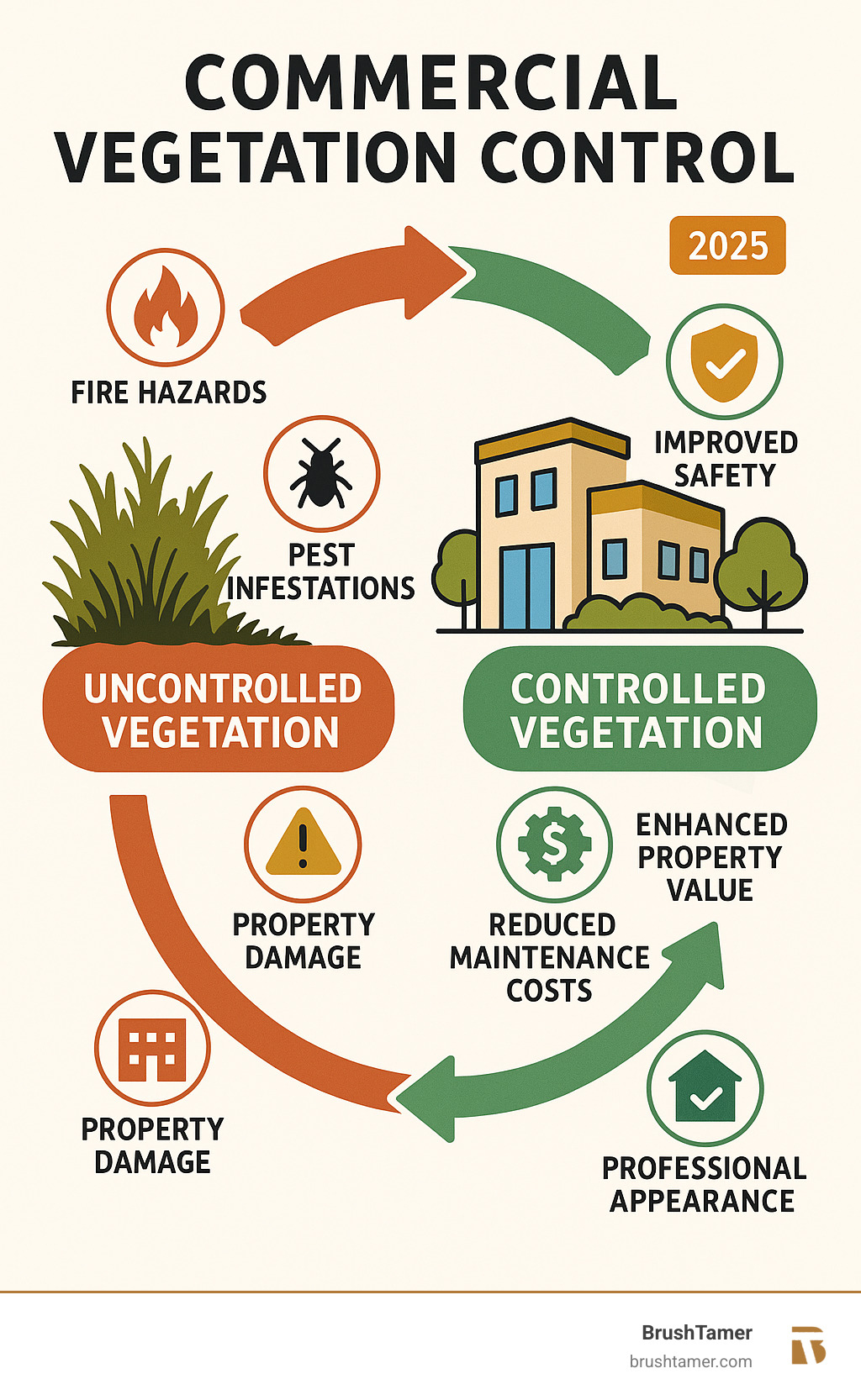
Why Vegetation Control is Non-Negotiable for Your Business
The Risks of Letting Nature Run Wild
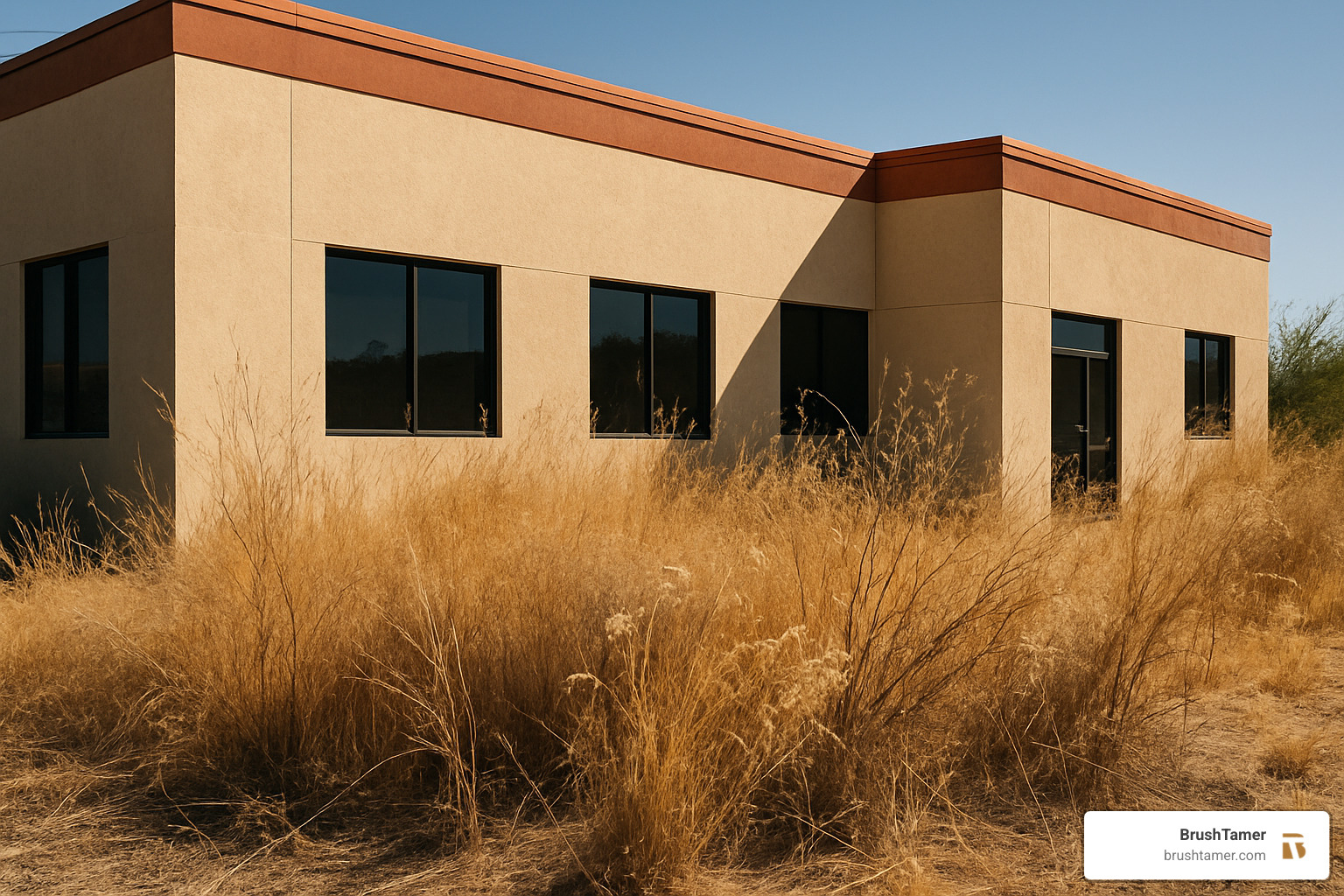
I’ve seen too many business owners learn the hard way that commercial vegetation control isn’t optional – it’s essential. What starts as a few weeds or some overgrown brush can quickly escalate into serious safety hazards, pest problems, and costly property damage.
Fire becomes your biggest enemy when vegetation gets out of control. Those innocent-looking dried grasses and dead brush? They’re essentially kindling waiting for a spark. Whether it’s a carelessly tossed cigarette, overheated equipment, or electrical issues, overgrown vegetation can turn a minor incident into a major disaster. The liability alone should keep any business owner awake at night.
But fire isn’t the only safety concern. Obstructed walkways create trip and fall hazards that can lead to serious injuries and lawsuits. When vegetation blocks emergency exits or covers security equipment, you’re not just facing safety risks – you’re potentially violating building codes and insurance requirements.
Pests love overgrown areas like teenagers love pizza. Dense vegetation provides perfect hiding spots for rodents, insects, and even snakes. These uninvited guests don’t just stay outside – they eventually find their way into your buildings, creating health hazards and potential damage to inventory or equipment.
The property damage from uncontrolled vegetation is often invisible until it’s expensive. Root systems work 24/7 to crack foundations, damage sidewalks, and clog drainage systems. When plants grow too close to buildings, they trap moisture against walls, leading to rot, corrosion, and structural problems that can cost thousands to repair.
Perhaps most concerning is the legal liability that comes with neglected vegetation management. Accidents happen, codes get violated, and insurance claims pile up. Professional commercial vegetation control helps protect your business from these costly scenarios while maintaining good relationships with your community.
Common Unwanted Vegetation on Commercial Properties
Understanding what you’re up against makes all the difference in effective vegetation management. In our work across the Midwest, we encounter several troublemakers that seem determined to make business owners’ lives difficult.
Annual grasses like crabgrass and foxtail spread faster than gossip in a small town. These opportunistic plants love disturbed soil and can quickly take over parking lots, walkways, and landscaped areas. Broadleaf weeds such as dandelions and plantain might look harmless, but they’re incredibly persistent and can crack through seemingly solid pavement.
Woody weeds and vines cause the most structural damage. Wild grape vines can literally pull down fences and damage buildings, while thorny species like multiflora rose create impenetrable barriers that block access and harbor pests.
The real villains are invasive species like buckthorn. These non-native plants have no natural enemies and can quickly dominate an area. Buckthorn, for instance, can grow up to 25 feet tall and produces berries that spread the problem even further. Noxious weeds are legally regulated in many areas, meaning property owners can face fines for allowing them to spread.
Early detection and consistent management are crucial for controlling these vegetation problems before they become expensive headaches.
Key Benefits of Professional Commercial Vegetation Control
The advantages of professional commercial vegetation control go far beyond making your property look neat and tidy. When done right, vegetation management becomes a strategic investment that pays dividends in multiple ways.
Improved safety is the most immediate benefit. Professional vegetation control eliminates hiding places for pests and wildlife while ensuring clear access to fire hydrants and emergency exits. This reduced fire risk not only protects your property but can also lower insurance premiums.
Your property’s improved appearance directly impacts your bottom line. First impressions matter, and customers form opinions about your business before they even walk through the door. Professional vegetation management helps increase property value while projecting competence and attention to detail.
Pest prevention through vegetation control is far more effective than trying to eliminate pests after they’ve already moved in. By removing their preferred habitats, you’re addressing the root cause rather than just treating symptoms.
Infrastructure protection might be the most valuable long-term benefit. Proper vegetation management prevents root damage to foundations, utilities, and paved surfaces, saving thousands in repair costs over time. Improved accessibility ensures that emergency equipment, walkways, and building entrances remain clear and functional.
Strong community relations develop when your property looks professional and well-maintained. This reputation can be invaluable for customer attraction and regulatory compliance.
The cost-effective maintenance approach of professional vegetation control prevents small problems from becoming expensive disasters. Regular management is always cheaper than emergency repairs and crisis management.
For businesses ready to protect their investment and reputation, more information about our services can help you understand how professional vegetation control transforms properties while reducing long-term costs.
The Toolkit: Methods and Techniques for Effective Control
Physical and Mechanical Methods

When it comes to commercial vegetation control, I’ve learned that the right tools make all the difference. After years of helping businesses reclaim overgrown properties, I can tell you that mechanical methods often deliver the best results while being kind to the environment.
The Forestry Mulching Revolution
If there’s one piece of equipment that’s transformed how we approach vegetation control, it’s the forestry mulcher. This machine is like having a small army of workers – it cuts, grinds, and mulches vegetation all in one pass, leaving behind a protective layer of organic material.
What makes forestry mulching so effective? First, it’s incredibly efficient. Instead of the old way of cutting, hauling debris, burning, and cleaning up, we get everything done in one step. The mulched material stays on-site, protecting the soil from erosion and gradually breaking down to add nutrients back to the ground.
But here’s what I really love about it – we can be selective. Need to clear dense brush but keep that beautiful oak tree? No problem. The forestry mulcher lets us work around valuable trees while eliminating unwanted vegetation. It’s precision work that protects what matters while removing what doesn’t.
Research backs up what we see in the field every day. Forestry mulching is an eco-friendly land clearing method that “clears land without disturbing the soil, suppresses weed growth, protects large trees and their roots, reduces erosion, and replenishes topsoil with nutrients as the mulch decomposes.”
Our Forestry Mulching Services can handle everything from overgrown fence lines to dense brush that’s been growing for years. It’s particularly effective for commercial properties where you need quick results without environmental damage.
Traditional Methods That Still Work
Don’t get me wrong – sometimes the old-school approaches are exactly what’s needed. Mowing works great for maintaining open areas and controlling annual weeds. But commercial properties often need more specialized cutting techniques.
Brush cutting tackles dense undergrowth that regular mowers can’t handle. Scrub cutting deals with woody vegetation that’s too tough for standard equipment. And when we need to preserve certain plants while removing others, selective cutting gives us the precision we need.
Dealing with Stumps
After tree removal, stumps become more than just eyesores – they’re safety hazards and perfect hiding spots for pests. That’s where our Stump Grinding and Removal Services come in. We eliminate these problems completely, leaving your property ready for whatever comes next.
The beauty of mechanical methods is their immediate impact. You can see the results right away, there are no chemical residues to worry about, and you have complete control over what gets removed. Plus, these methods actually improve long-term soil health while keeping you compliant with environmental regulations.
Responsible Vegetation Management Solutions
While mechanical methods form the core of our approach, I believe in being honest about the full toolkit available for commercial vegetation control. Sometimes, a comprehensive strategy requires additional methods – and when that’s the case, we emphasize responsible practices that protect both your property and the environment.
The Integrated Approach
At BrushTamer, we follow what’s called Integrated Vegetation Management (IVM). Think of it as using the right tool for the right job at the right time. We start with a thorough site assessment to understand exactly what we’re dealing with. Then we select the best combination of methods based on the vegetation type, environmental factors, and your specific needs.
Timing matters tremendously in vegetation control. What works in spring might not be effective in fall. Environmental protection is always our priority, which means we’re selective about when and how we apply any treatments. And we’re always thinking long-term – how can we prevent problems from coming back?
When Additional Methods Make Sense
There are situations where targeted herbicide application might be appropriate as part of a comprehensive vegetation management plan. Pre-emergent treatments can prevent weed seeds from germinating in the first place. Post-emergent control deals with established problem vegetation that’s already growing.
Selective herbicides target specific types of plants without harming others. Residual control provides longer-term suppression in areas where you need extended protection. The key is using these methods strategically, not as a first resort.
Safety and Environmental Responsibility
When chemical methods are part of the solution, we take every precaution. Our team includes properly licensed and certified applicators who understand the science behind what they’re doing. We protect water sources and non-target plants through careful application timing and drift prevention measures.
Regulatory compliance isn’t just about following the law – it’s about doing what’s right for your property and the surrounding environment. We stay current with all applicable regulations and industry best practices.
Our Commitment to Sustainability
Here’s what sets us apart: we minimize chemical inputs whenever possible. We use the least toxic effective methods and always protect beneficial insects and wildlife. Maintaining soil health and water quality isn’t just good business – it’s the right thing to do.
This integrated approach means we’re not just solving today’s vegetation problems. We’re creating conditions that support the long-term health of your property while reducing future maintenance needs.
If you’re interested in learning more about how we balance effectiveness with environmental responsibility, contact us for more information about safe vegetation management. We’re happy to discuss the best approach for your specific situation.
The Professional Approach to Commercial Vegetation Control
Target Zones: Where is Control Most Critical?
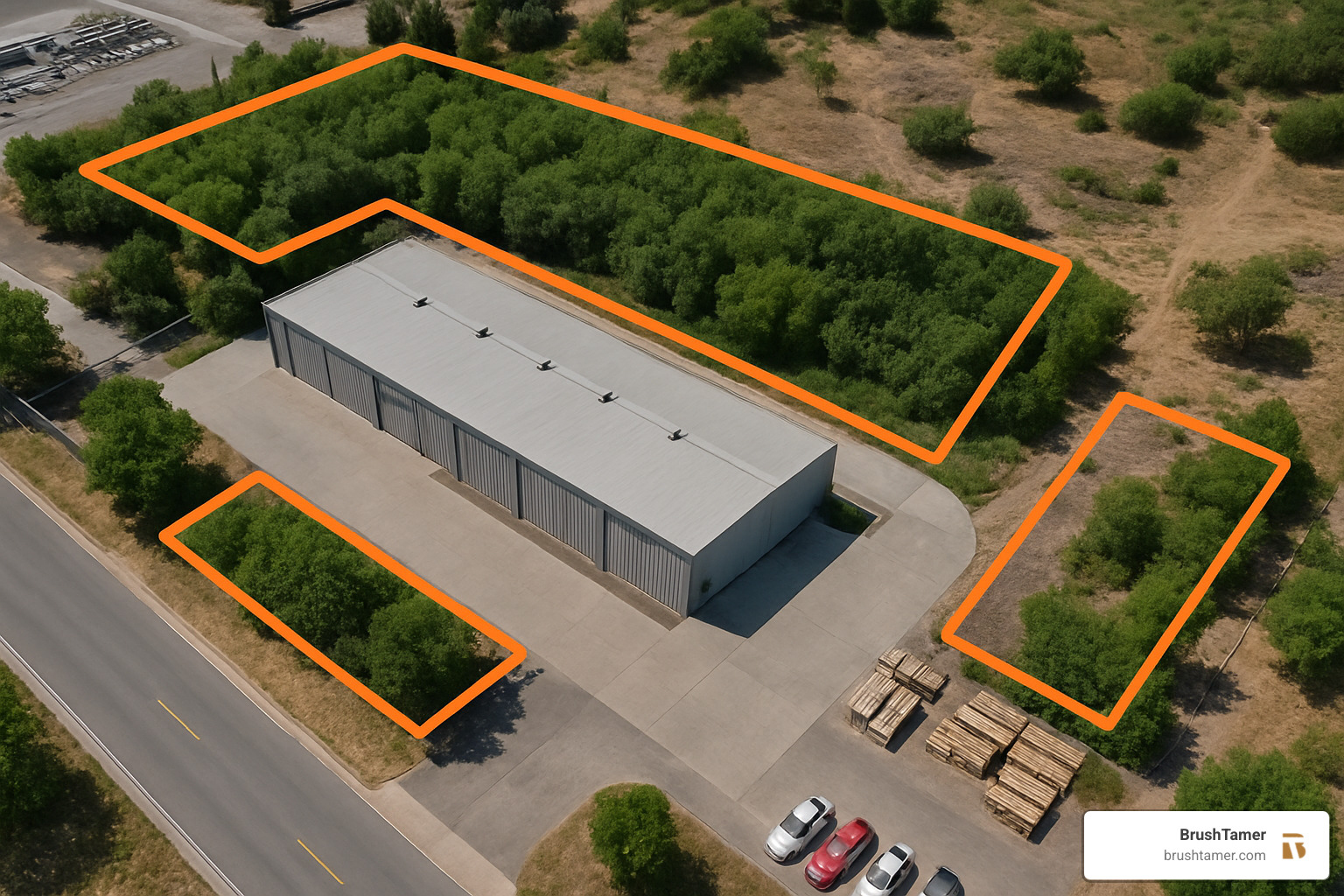
After years of helping businesses reclaim their properties, I’ve learned that smart commercial vegetation control isn’t about clearing everything in sight. It’s about focusing your efforts where they’ll have the biggest impact on safety, operations, and your bottom line.
Think of it like home maintenance – you wouldn’t spend the same amount of time cleaning your closet as you would your kitchen. The same principle applies to vegetation management on commercial properties.
Building Perimeters: Your First Line of Defense
The area around your buildings deserves the most attention. When vegetation grows too close to structures, it creates a perfect storm of problems. Moisture gets trapped against foundations, leading to expensive structural damage over time. Pests find convenient highways right to your doorstep. And in dry conditions, overgrown areas become fire hazards threatening your most valuable assets.
We typically recommend maintaining a clear zone of 10-30 feet around buildings, depending on your structure type and local fire codes. This isn’t just good practice – it’s often required by insurance companies and safety regulations.
Parking Lots and Paved Surfaces: Small Problems, Big Consequences
Those little weeds poking through pavement cracks might seem harmless, but they’re actually working overtime to destroy your surfaces. Root systems act like tiny jackhammers, widening cracks and creating trip hazards. What starts as a minor aesthetic issue quickly becomes a major liability and repair expense.
Regular vegetation control in these areas prevents costly repaving while maintaining the professional appearance that customers expect.
Fence Lines: More Than Just Boundaries
Overgrown fence lines create security blind spots and damage expensive fencing materials. They also make it harder to maintain good relationships with neighbors – nobody wants to look at a jungle growing along their property line.
Clear fence lines also make it easier for security teams to monitor your property and spot potential problems before they escalate.
Storage Areas and Utility Zones: Operational Efficiency
Industrial properties have unique needs when it comes to vegetation control. Gravel storage areas can become contaminated with seeds and organic matter. Utility substations require clear zones for both safety and operational access. Loading docks need unobstructed access for safe material handling.
I’ve seen too many businesses struggle with equipment damage or operational delays because vegetation wasn’t properly managed in these critical areas.
Infrastructure Protection: The Hidden Costs
Some of the most expensive vegetation problems happen out of sight. Drainage ditches clogged with plant growth can cause flooding during heavy rains. Utility corridors blocked by vegetation can lead to service interruptions. Access roads and fire lanes must remain clear for emergency vehicles – it’s not just good practice, it’s the law.
Specialized Commercial Environments
Different industries face unique vegetation challenges. Solar farms need bare ground maintenance to maximize energy production. Railways require clear corridors for safe operations. Steep slopes need careful management to prevent erosion while controlling unwanted growth.
Each environment requires a custom approach that considers both operational needs and environmental responsibility.
Our Land Clearing Services can address all these specialized needs with the right equipment and techniques for your specific situation.
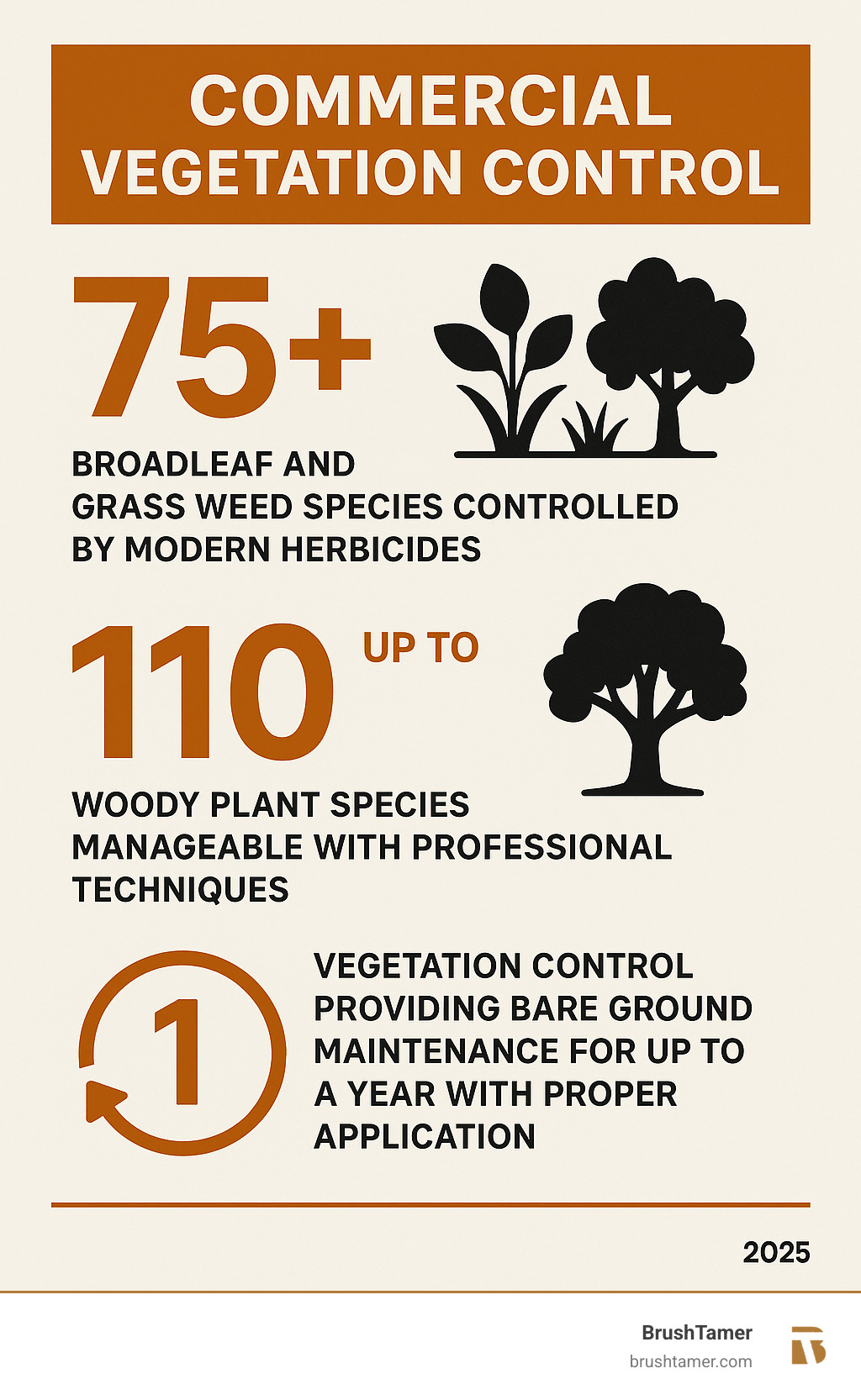
The key to successful commercial vegetation control is understanding that every property is different. What works for a manufacturing plant might not be right for a retail center. That’s why we start every project with a thorough assessment to identify your specific high-priority zones and develop a management plan that makes sense for your business.
Frequently Asked Questions about Commercial Vegetation Control
How often is commercial vegetation control needed?
When property owners ask me about maintenance schedules, I always tell them the same thing: it depends on what you’re dealing with and what you want to achieve. There’s no one-size-fits-all answer, but I can share what we’ve learned from years of helping businesses across the Midwest.
The Growing Season Makes All the Difference
Here in the Midwest, vegetation doesn’t grow at the same pace year-round. Spring and early summer are when plants really take off. Most commercial properties benefit from a spring treatment in April or May to catch emerging weeds before they establish. Then we typically recommend summer maintenance between June and August to keep things under control. A fall preparation treatment in September or October helps set you up for success next season.
Different Plants, Different Schedules
The type of vegetation you’re dealing with dramatically affects timing. Annual weeds are aggressive but predictable – they usually need attention 2-3 times during the growing season. Perennial vegetation has deeper root systems and might need less frequent but more intensive treatment.
Woody plants like the invasive buckthorn we see so often may only need annual or biennial management, but they require early detection and consistent management to prevent them from taking over. Invasive species are particularly tricky because they don’t follow the same rules as native plants.
Your Property Type Matters
A retail storefront has different needs than an industrial facility. Retail locations where customers form first impressions might need monthly attention during the growing season. Industrial sites can often get by with quarterly maintenance, while utility facilities typically follow annual management cycles. Storage facilities might only need seasonal treatments.
The key is matching the maintenance schedule to your business needs and budget. We’ve found that preventative maintenance is always more cost-effective than reactive treatment. It’s much easier to prevent a problem than to fix one that’s gotten out of hand.
Is commercial vegetation control safe for the environment?
This is probably the question I get asked most often, and I’m glad people are thinking about it. Environmental safety isn’t just important to our clients – it’s central to everything we do at BrushTamer.
We Start with the Gentlest Methods
Our approach follows Integrated Vegetation Management (IVM) principles, which means we use science-based practices that minimize environmental impact. We prioritize selective methods that target problem vegetation while protecting the plants and wildlife you want to keep around.
Whenever possible, we start with mechanical methods like forestry mulching. These techniques offer huge environmental advantages: no chemical residues in soil or water, improved soil structure as organic matter decomposes, and reduced erosion because we’re not disturbing the soil structure.
When you see our forestry mulcher in action, you’ll understand why we love this approach. It clears problem vegetation while leaving behind a protective layer of mulch that actually improves soil health over time.
When Other Methods Are Needed
Sometimes mechanical methods aren’t enough, especially with persistent invasive species. When we do need to consider other approaches, we follow strict guidelines: minimum effective amounts, products with favorable environmental profiles, and optimal weather conditions for application.
We always protect water sources and sensitive areas, and we follow all regulatory requirements. Our certified applicators understand that protecting the environment isn’t just good practice – it’s essential for long-term success.
Active Environmental Protection
Our methods don’t just avoid harming the environment – they actively protect it. The mulch from our forestry operations provides erosion control and helps prevent runoff in sensitive areas. We maintain soil organic matter and support the beneficial organisms that keep ecosystems healthy.
Learn more about our environmentally conscious approach through our Integrated Vegetation Management services.
Can vegetation management prevent pest infestations?
Absolutely, and this is one of the most compelling reasons to invest in commercial vegetation control. I’ve seen it happen countless times – businesses that thought they had a pest problem actually had a vegetation problem that was attracting pests.
Taking Away the Welcome Mat
Think about it from a pest’s perspective. Dense brush provides perfect shelter for rodents and small mammals. Tall grasses create ideal habitat for ticks and other insects. Woody areas offer nesting sites, while debris accumulation creates breeding grounds.
Research backs this up completely. Industry studies show that weed control programs can reduce insect and rodent harborages, and that routine vegetation control limits hiding places and habitats for pests and wildlife nuisances.
The Pest Prevention Benefits Are Real
When we clear overgrown areas, we’re eliminating shelter and food sources that attract rodents. We’re removing the tall grass habitat where ticks thrive. We’re reducing the cover and prey availability that draws snakes to an area. And we’re disrupting the breeding and feeding areas that support various insect populations.
A Comprehensive Approach Works Best
The most effective strategy combines vegetation control with other pest management practices. We recommend regular monitoring for early problem detection, habitat modification to discourage pest establishment, and exclusion methods to prevent access to buildings.
This integrated approach creates environments that are naturally less attractive to pests. Instead of constantly fighting pest problems after they develop, you’re preventing them from establishing in the first place. It’s more effective, more economical, and creates healthier spaces for your employees and customers.
The best part? Consistent vegetation management reduces the need for chemical pest control, which aligns perfectly with our environmentally responsible approach.
Conclusion: Reclaim Your Property for Safety and Success
When I started BrushTamer, I saw too many business owners struggling with the same problem: vegetation that had gotten out of control, creating safety hazards, damaging property, and making their businesses look unprofessional. What many don’t realize is that commercial vegetation control isn’t just about keeping things looking neat – it’s about protecting everything you’ve worked to build.
Throughout this guide, we’ve explored the real risks that uncontrolled vegetation poses to your business. From fire hazards that can destroy property to pest infestations that create health concerns, overgrown vegetation is far more than a cosmetic issue. It’s a serious business risk that affects your bottom line, your safety compliance, and your professional reputation.
The good news is that professional vegetation management delivers benefits that extend far beyond what most property owners expect. Improved safety comes from clear access routes and eliminated hazards. Increased property value results from preventing damage and maintaining that professional appearance that makes such a strong first impression. Pest prevention happens naturally when you eliminate the harborage areas where rodents, insects, and other unwanted visitors love to hide.
But perhaps most importantly, proper vegetation control gives you fire risk reduction through smart fuel load management, infrastructure protection by preventing costly root damage, and regulatory compliance that keeps you out of trouble with safety inspectors and insurance companies.
In my years of working across the Midwest, I’ve learned that the most effective approach combines multiple strategies custom to each property’s unique challenges. Sometimes that means bringing in our forestry mulching equipment for large-scale clearing. Other times it’s targeted treatments for specific problem areas or setting up ongoing maintenance programs that prevent issues before they start.
At BrushTamer, we’ve built our reputation on delivering reliable, high-quality results with a client-focused approach that respects both your budget and the environment. We work with you to develop solutions that fit your timeline and operational requirements while delivering the consistent results your business deserves.
The investment in professional commercial vegetation control pays for itself through reduced liability, lower maintenance costs, improved safety, and improved property value. More importantly, it gives you the peace of mind that comes from knowing your property is properly maintained and protected.
Your business success shouldn’t be compromised by something as manageable as vegetation control. Take control of your property with professional Land Clearing Services and find how proper vegetation management can transform your commercial property into the safer, more valuable, and more attractive business asset it should be.
